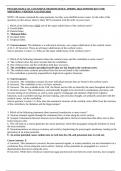lOMoARcPSD|12265847
PSYCH/COGSCI 127, COGNITIVE NEUROSCIENCE, SPRING 2024 ANSWER KEY FOR
MIDTERM 1 VERSION A (14 FEB 2024)
NOTE: All exams contained the same questions, but they were shuffled across exams. So the order of the
questions on this answer sheet is likely NOT consistent with the order on your exam.
1. Which of the following is NOT one of the major subdivisions of the cerebral cortex?
A. Frontal lobes.
B. Parietal lobes.
C. Thalamal lobes.
D. Occipital lobes.
E. Temporal lobes.
C: Correct answer. The thalamus is a subcortical structure, not a major subdivision of the cerebral cortex.
A, B, C, D: Incorrect. These are all major subdivisions of the cerebral cortex.
Source question: Lecture 1.2, What are the major subdivisions of the cerebral cortex?
2. Which of the following statements about the cerebral cortex and the cerebellum is most correct?
A. The cerebral cortex has more neurons than the cerebellum.
B. The cerebral cortex and the cerebellum both have six layers.
C. The cerebellum contains specialized nuclei that are not found in the cerebral cortex.
D. The cerebral cortex contains specialized ions that are not found in the cerebellum.
E. The cerebellum is primarily responsible for high-level cognitive functions.
C: Correct answer.
A: Incorrect. The cerebellum contains far more individual neurons than are found in the cerebral cortex.
B: Incorrect. The cerebellum is not a six-layer structure.
D: Incorrect. The ions available in the CSF, the blood, and in cells are basically the same throughout the brain
E: Incorrect answer: The cerebellum is conventionally thought to be involved in coordination, precision, and
accurate timing of movements, as well as some aspects of language and attention. High-level cognitive
functions, such as problem-solving, decision-making, and conscious thought, are primarily associated with the
cerebral cortex, not the cerebellum
Source question: Lecture 1.2, How does the anatomical structure of the cerebral cortex differ from the structure
of the cerebellum, the thalamus and the hippocampus?
3. Which of the following statements about neuronal transduction is most correct?
A. Neurons transmit signals through the continuous flow of ions along the axon's surface.
B. Synaptic transmission between neurons occurs through direct electrical connections that allow ions to flow
freely between cells.
C. The cell body of a neuron generates the action potential, which then propagates along the dendrites to reach
the axon terminals.
D. Neurotransmitters are always excitatory and work by depolarizing the postsynaptic membrane, leading to the
generation of an action potential.
E. An action potential causes sodium ions to rush into the cell, and potassium ions to rush out.
Correct answer: E
A: Incorrect. This statement is incorrect because neuronal signals, or action potentials, are not transmitted via a
continuous flow of ions along the axon's surface. Instead, action potentials are propagated as a wave of
depolarization that moves along the axon.
B: Incorrect. While direct electrical connections (gap junctions) do exist between some neurons, most synaptic
, lOMoARcPSD|12265847
transmission is chemical, not electrical.
C: Incorrect. This statement is incorrect because action potentials are typically initiated in the axon hillock, a
specialized region of the neuron near the junction of the axon and the cell body.
D: Incorrect. This statement is incorrect because neurotransmitters can be either excitatory or inhibitory,
depending on their type and the receptors they bind to on the postsynaptic neuron.
Source question: Lecture 1.2, How does a neuron transform a signal from input to output (explain entire
process)?
4. What are the three spatial planes used to slice the brain?
A. Horizontal, sagittal, coronal.
B. Ventral, dorsal, lateral.
C. Medial, dorsal, coronal.
D. Horizontal, dorsal, sagittal.
E. Circumverate, lateral, coronal.
A. Correct
B, C, D, E: Incorrect. Medial, dorsal and coronal refer to views of the brain, not to how the brain is sliced or
sectioned. The term circumverate is meaningless.
Source question: Lecture 1.2, What are the three spatial planes used to slice/visualize the brain?
5. What is the difference between gray matter and white matter?
A. Gray matter contains more granulocites than are found in white matter.
B. Gray matter consists of neurons making relatively local connections, while white matter consists
of neurons making long-range connections.
C. Gray matter is an evolutionary specialization of primates, whereas white matter is found in all mammals.
D. Gray matter conducts signals faster than does white matter.
E. Gray matter indicates healthy brain tissue, while while matter indicates a disease state.
B: Correct
A: Incorrect. There are no granulocites.
C: Incorrect. Both gray and white matter are common in all mammals.
D: Incorrect. White matter conducts signals faster than does gray
matter.
E. Incorrect. Both gray and white matter are found in healthy brains.
Source question: Lecture 1.2, What is the difference between gray matter and white matter?
6. Why does the brain have topographic maps?
A. Topographic maps are random neural arrangements without any functional significance.
B. Topographic maps segregate different types of sensory information, keeping them entirely separate
within the brain.
C. Topographic maps are required to ensure that a neural network can compute complex functions
D. Topographic maps minimize wiring length by placing neurons that represent similar values of some
dimension nearby one another, and neurons that represent very different values of that dimension
farther away.
E. Topographic maps are an evolutionary artifact reflecting the organization of brains in simpler animals
Correct answer: D
A: Incorrect. This statement is incorrect because topographic maps are not random; they are highly organized in
a way that reflects the spatial or functional organization of a particular sensory or motor modality. This
organization is crucial for efficient processing and interpretation of sensory inputs and motor outputs.




